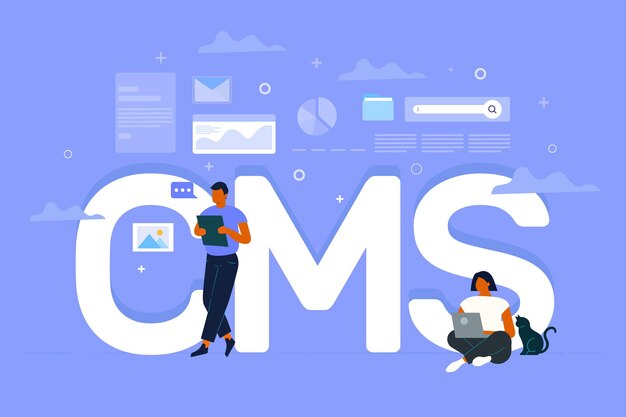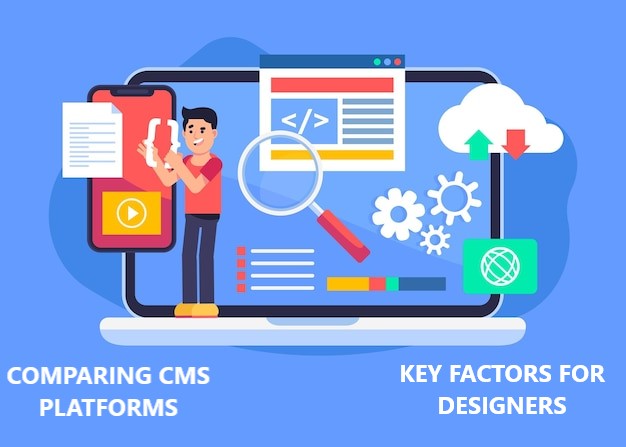The rise of CMS platforms has transformed the web design landscape, empowering designers and developers to create stunning websites without needing to code every element from scratch. For a CMS web design designer, understanding the strengths and weaknesses of each platform is crucial to selecting the best tool for each project. In this comprehensive blog, we will explore the differences between the most popular CMS platforms, helping designers choose the right one for their needs.
Page Contents
What is a CMS?
A Content Management System (CMS) is software that allows users to build, edit, and manage website content without requiring advanced technical skills. These platforms come equipped with intuitive user interfaces, drag-and-drop tools, and pre-designed templates that enable designers to create websites quickly and efficiently.
For a CMS web design designer, using a CMS helps streamline the workflow, allowing more time to focus on creativity and less on technical challenges. The flexibility offered by these platforms means designers can work with clients across industries, tailoring the design to meet individual business goals.
Why CMS Matters for Designers

A CMS web design designer needs a platform that balances simplicity and flexibility. Choosing the right CMS can enhance productivity, improve user experiences, and provide long-term scalability for clients.
Here’s why CMS platforms are crucial for designers:
- Time-Saving: CMS platforms reduce the amount of coding required, enabling designers to focus on layout, aesthetics, and user experience.
- Customizable: They offer various customization tools, templates, and themes, allowing designers to deliver unique and tailored websites.
- Responsive: Most CMS platforms offer mobile-friendly designs, crucial for the modern web experience.
- SEO-Friendly: SEO tools integrated within CMS platforms help websites rank better in search engines, an essential feature for businesses looking to expand their online presence.
In short, for a CMS web design designer, selecting the right CMS can mean the difference between a smoothly executed project and endless frustrations.
Top CMS Platforms Overview
WordPress
WordPress is the most popular CMS in the world, powering over 40% of all websites. Its massive library of themes, plugins, and user-friendly interface makes it an excellent choice for beginners and experienced designers alike.
- Pros:
- Extremely flexible with thousands of plugins and themes.
- Strong SEO tools and capabilities.
- Huge community support.
- Cons:
- Requires regular maintenance.
- Can be resource-heavy, affecting performance if not optimized.
Joomla
Joomla is an open-source CMS known for its balance between flexibility and ease of use. It’s more complex than WordPress but offers more built-in functionality, making it a favorite among designers who want to build more sophisticated websites without relying heavily on third-party plugins.
- Pros:
- Flexible in terms of customization.
- Strong user management features.
- Ideal for social networking sites.
- Cons:
- A steeper learning curve than WordPress.
- Fewer themes and plugins available compared to WordPress.
Drupal
Drupal is often the CMS of choice for large-scale and enterprise-level websites. It offers a high level of customization, but the complexity of the platform means it is generally suited for experienced designers and developers.
- Pros:
- Highly customizable and scalable.
- Ideal for large and complex websites.
- Excellent security features.
- Cons:
- Steeper learning curve.
- Limited themes and templates.
Squarespace
Squarespace is a hosted CMS platform designed to help users create visually appealing websites with ease. Its drag-and-drop builder and stunning templates make it a great choice for designers looking to create sleek, modern websites quickly.
- Pros:
- Easy to use, even for beginners.
- Beautiful, professionally designed templates.
- Built-in hosting and security.
- Cons:
- Limited customization compared to WordPress or Joomla.
- Not ideal for large or complex websites.
Wix
Wix is another popular hosted CMS with a strong focus on simplicity and ease of use. With its drag-and-drop interface, Wix makes it possible for users with no coding experience to build beautiful websites.
- Pros:
- Very easy to use with intuitive drag-and-drop tools.
- A wide range of templates designed for various industries.
- Good for small businesses or personal websites.
- Cons:
- Limited flexibility for advanced customization.
- Migrating to another platform can be difficult.
Comparing CMS Platforms: Key Factors for Designers

When deciding which platform to use, a CMS web design designer should consider several critical factors. Let’s compare the leading CMS platforms across these areas.
Ease of Use
- WordPress: Known for its easy-to-use dashboard, though advanced users can dig into coding for more control.
- Joomla: Slightly more complex but still user-friendly with some learning curve.
- Drupal: Highly complex, best suited for designers with development skills.
- Squarespace: Extremely easy to use with a drag-and-drop interface.
- Wix: One of the easiest CMS platforms for non-tech-savvy users.
Customization Options
- WordPress: Offers extensive customization through themes, plugins, and custom code.
- Joomla: Highly customizable with modules, but requires more technical skills.
- Drupal: The most customizable, with endless possibilities for developers.
- Squarespace: Limited customization but very flexible within the bounds of its templates.
- Wix: Limited customization compared to open-source platforms.
Themes and Templates
- WordPress: Over 11,000 themes available, both free and paid.
- Joomla: Several free and premium templates, but fewer than WordPress.
- Drupal: Limited number of themes, requires coding for customization.
- Squarespace: High-quality templates but limited in number.
- Wix: Offers a wide variety of industry-specific templates.
SEO Capabilities
- WordPress: Strong SEO tools with plugins like Yoast SEO.
- Joomla: Good SEO capabilities but requires manual optimization.
- Drupal: Excellent for SEO, but requires developer expertise.
- Squarespace: Decent SEO tools but lacks the flexibility of WordPress.
- Wix: Basic SEO tools, not as robust as WordPress or Drupal.
Security Features
- WordPress: Requires third-party plugins for security enhancements.
- Joomla: Offers good built-in security features.
- Drupal: Known for its advanced security options, suitable for government websites.
- Squarespace: Built-in security features with regular updates.
- Wix: Basic security, but adequate for small sites.
E-commerce Capabilities
- WordPress: WooCommerce plugin provides powerful e-commerce capabilities.
- Joomla: Supports e-commerce through extensions like VirtueMart.
- Drupal: Excellent for complex e-commerce sites with a large number of products.
- Squarespace: Built-in e-commerce tools suitable for small businesses.
- Wix: Basic e-commerce tools, not suitable for large-scale stores.
Which CMS is Best for You as a CMS Web Design Designer?
For a CMS web design designer, the best platform largely depends on the nature of the project and the client’s needs. Here’s a summary of the best uses for each CMS platform:
- WordPress: Ideal for general-purpose websites, blogs, small businesses, and e-commerce sites.
- Joomla: A good middle ground between flexibility and ease of use, suitable for more complex websites.
- Drupal: Perfect for large organizations, government websites, and enterprises requiring a high degree of customization.
- Squarespace: Great for designers looking for a quick, visually appealing solution for small businesses or portfolios.
- Wix: Ideal for small businesses, personal websites, or users who prioritize ease of use over customization.
The right platform for a CMS web design designer should match both the designer’s expertise and the client’s specific goals. For beginners, WordPress or Wix might be the best choice, while seasoned designers may gravitate towards Joomla or Drupal for more complex, feature-rich websites.
Future Trends in CMS Web Design
As web design continues to evolve, so too do CMS platforms. Here are some trends that every CMS web design designer should keep in mind:
- AI Integration: Expect to see more CMS platforms leveraging AI to enhance design automation, content creation, and user experience.
- Headless CMS: A growing trend where the CMS separates the back-end from the front-end, offering more flexibility in design and development.
- Mobile-First Design: CMS platforms are likely to continue optimizing for mobile-first experiences, as mobile web usage outpaces desktop.
- Enhanced Security: As cyber threats increase, CMS platforms are likely to implement more robust security features.
By staying ahead of these trends, a CMS web design designer can continue delivering cutting-edge solutions for clients.
Conclusion
For any CMS web design designer, understanding the differences between CMS platforms is essential for delivering successful web design projects. Whether it’s the flexibility of WordPress, the complexity of Drupal, or the simplicity of Squarespace, each platform offers unique strengths that can be matched to specific client needs.
By selecting the right CMS for the job, designers can streamline their workflow, enhance user experience, and ensure that each website not only looks great but also functions smoothly. Ultimately, the right CMS will depend on the designer’s skill set, the project’s requirements, and the client’s long-term goals.




